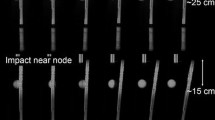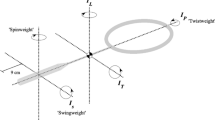Abstract
There has been significant technological advancement in the game of tennis over the past two decades. In particular, tennis rackets have changed in size, shape and material composition. The effects of these changes on ball rebound speed have been well documented, but few studies have considered the effects on ball angular velocity. The purpose of this study was to investigate the effects of three factors on post-impact ball spin. Tennis balls were projected at three velocities toward a clamped racket simulating three levels of stiffness and strung at three string tensions. The angular velocity of each tennis ball was measured from stroboscopic images during an oblique impact with the racket. A three-way factorial ANOVA revealed significant (P < 0.01) differences in the post-impact angular velocity for string tension, racket stiffness and impact velocity, as well as two-way interactions between string tension and impact velocity, and between racket stiffness and impact velocity. The possibility of tangential elastic strain energy being stored in the racket and ball was evident in low impact velocity trials. These displayed a post-impact angular velocity where the circumference of the ball was translating faster than the relative velocity between the ball’s centre of mass and the string surface. It was concluded that increasing the relative impact velocity between the racket and ball was the best means of increasing the post-impact angular velocity of the tennis ball.
Similar content being viewed by others
References
Andrews, J. (1983) A mechanical analysis of a special class of rebound phenomena.Medicine & Science in Sports & Exercise,15(3), 256–266.
Baker, J. & Wilson, B. (1978) The effect of tennis racket stiffness and string tension on ball velocity after impact.The Research Quarterly,49(3), 255–259.
Bower, R. & Sinclair, P. (1999) Tennis racquet stiffness and string tension effects on rebound velocity and angle for and oblique impact.Journal of Human Movement Studies,37, 271–286.
Brannigan, M. & Adali, S. (1981) Mathematical modelling and simulation of a tennis racket.Medicine & Science in Sports & Exercise,13(1), 44–53.
Brody, H. (1979) Physics of the tennis racket.American Journal of Physics,47(6), 482–487.
Brody, H. (1981) Physics of the tennis racket II: The ‘sweet spot’.American Journal of Physics,49(9), 816–819.
Brody, H. (1997) The physics of tennis III. The ball-racket interaction.American Journal of Physics,65(10), 981–987.
Brody, H., Cross, R. and Lindsey, C. (2002)The Physics and Technology of Tennis. United States Racquet Stringers Association, California, USA.
Cross, R. (2002) Measurements of the horizontal coefficient of restitution for a superball and a tennis ball.American Journal of Physics,70(5), 482–489.
Elliott, B.C. (1982) The influence of tennis racket flexibility and string tension on rebound velocity following a dynamic impact.Research Quarterly for Exercise & Sport,53(4), 277–281.
Elliott, B.C., Marsh, A.P. and Overheu, P.R. (1987) The Mechanics of the Lendl and conventional tennis forehands: A coach’s perspective.Sports Coach,11(2), 4–9
Elliott, B.C., Marsh, A.P. and Overheu, P.R. (1989) The topspin backhand drive in tennis: A biomechanical analysis.Journal of Human Movement Studies,16(1), 1–16.
Goodwill, S.R. and Haake, S.J. (2004) Ball spin generation for oblique impacts with a tennis racket.Society for Experimental Mechanics,44(2), 195–206.
Groppel, J., Dillman, C. and Lardner, T. (1983) Derivation and validation of equations of motion to predict ball spin upon impact in tennis.Journal of Sports Sciences,1, 111–120.
Groppel, J., Shin, I., Thomas, J. & Welk, G. (1987) The effects of string type and tension on impact in midsized and oversized tennis rackets.International Journal of Sport Biomechanics,3, 40–46.
Hatze, H. (1976) Forces and duration of impact, and grip tightness during the tennis stroke.Medicine & Science in Sports,8(2), 88–95.
Hatze, H. (1993) The relationship between the coefficient of restitution and energy losses in tennis rackets.Journal of Applied Biomechanics,9, 124–142.
Leigh, D. & Lu, W. (1992) Dynamics of the interactions between ball, strings and racket in tennis.International Journal of Sport Biomechanics,8, 181–206.
Maw, N., Barber, J.R. & Fawcett, J.N. (1976) The oblique impact of elastic spheres.Wear,38, 101–114.
Putnam, C.A. & Baker, J.A. (1984) Spin imparted to a tennis ball during impact with conventionally and diagonally strung rackets.Research Quarterly for Exercise & Sport,55(3), 261–266.
Author information
Authors and Affiliations
Corresponding author
Rights and permissions
About this article
Cite this article
Bower, R., Sinclair, P. Tennis racket stiffness, string tension and impact velocity effects on post-impact ball angular velocity. Sports Eng 10, 111–122 (2007). https://doi.org/10.1007/BF02844208
Issue Date:
DOI: https://doi.org/10.1007/BF02844208




